Companies need to cultivate patient-centricity from the inside out.
Not much more than five years ago, UCB was one of the first pharma companies to bring patient centeredness deep into its culture, moving away from the traditional product-based model driven by revenue growth and sales toward the goal of creating value for each and every patient.
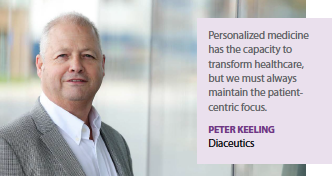 According to a white paper published by WEGO, this change in focus and approach first affected the ways UCB conducted its product development and service design. For example, cross-functional teams are now in place to focus on a particular therapeutic area, instead of having the company organized by function. Products and services are now designed around the patient’s experience and point of view. New principles have been embedded in its corporate culture and employees’ daily work habits as a result. UCB’s cultural mantra has become: “What difference can I make in the lives of people living with severe chronic diseases?"
According to a white paper published by WEGO, this change in focus and approach first affected the ways UCB conducted its product development and service design. For example, cross-functional teams are now in place to focus on a particular therapeutic area, instead of having the company organized by function. Products and services are now designed around the patient’s experience and point of view. New principles have been embedded in its corporate culture and employees’ daily work habits as a result. UCB’s cultural mantra has become: “What difference can I make in the lives of people living with severe chronic diseases?"
Since UCB’s initiative, many more pharma companies have begun to integrate patient-focused thinking into their organization by creating patient programs, identifying patient-focused leaders, and creating patient-centric departments.
Astellas, Novartis, and Janssen, among others followed suit, shifting to a new paradigm that radiates from the core of each company.
Astellas implemented the Patient Experience Organization in 2016; the initial focus was on health literacy and making clinical trial information easier to access and understand. The patient experience team continues to work with all other departments across Astellas to ensure that the voice of the patient is incorporated across all facets of the company.
Several patient-focused initiatives aimed at improving patient outcomes through increased 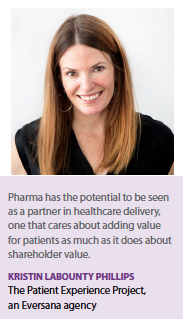 engagement have come out of that first program. For example, Astellas US and the Academy of Oncology Nurse & Patient Navigators have collaborated to develop, standardize, and validate an evidence-based, oncology navigation-specific acuity tool. The tool will determine the level of support cancer patients need from their oncology teams to help them better understand their disease, treatment options, and next steps, and to empower greater engagement in their care along their journey.
engagement have come out of that first program. For example, Astellas US and the Academy of Oncology Nurse & Patient Navigators have collaborated to develop, standardize, and validate an evidence-based, oncology navigation-specific acuity tool. The tool will determine the level of support cancer patients need from their oncology teams to help them better understand their disease, treatment options, and next steps, and to empower greater engagement in their care along their journey.
More recently, Astellas collaborated with WiserCare, a company that develops healthcare decision support solutions, to improve patient experience by eliciting and integrating patient feedback to improve patient communication and shared decision-making tools. This project will examine how patients learn about their disease states or conditions, including their options for treatment, and will test various approaches to communicating the risks and benefits of these options. Astellas and WiserCare hope these efforts will reduce patient anxiety and increase satisfaction with their decisions, improve adherence to care plans, and improve the overall care experience.
“Astellas seeks unique and innovative external collaborations to deliver value beyond traditional pathways," says Doug Noland, head of patient experience, executive director, Astellas US in a company announcement. “We feel there is great potential to better help patients navigate the hundreds of decisions they make during their journey." The project is expected to be completed in January 2020.
Pharma Perception Vs. Patient Reality
One of the conundrums of patient centricity in pharma has to do with perception. While companies may be collecting information from patients and caregivers, or creating add on services for patients, does that make its internal culture patient-focused? Some experts say maybe not so much.
“There are organizations we’ve worked with that feel they are very patient-centric," says Adam Connor, VP of design transformation at Mad*Pow. “They talk about the patients all the time. But 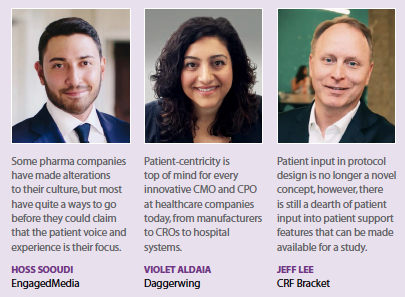 when we begin to probe into the depth of understanding: How much do they really know about these patients? How much do they really know about the stories and the opportunities for improving these patients’ situations? It’s on that qualitative side that they often need help."
when we begin to probe into the depth of understanding: How much do they really know about these patients? How much do they really know about the stories and the opportunities for improving these patients’ situations? It’s on that qualitative side that they often need help."
Mr. Connor and his team look closely at company culture and all of the ways that this is expressed and reinforced. They explore how beliefs, behaviors, and perceptions influence such things as roles, structure, processes, and tools that organizations use every day. They then work collaboratively to identify meaningful changes that teams can make to improve their capacity to design solutions and work together creatively.
“I’ve worked with groups that have all the information they need," Mr. Connor says. “They go out and they do good research and they make a commitment to talk to patients, but when they get that information back into the organization, it doesn’t move to the next step of influencing decisions and stimulating action. So the issue is more about operationalizing the insight collected."
Being able to capture and address the patient voice at scale — while remaining personally relevant and valuable to patients — is a real challenge for many pharma companies, says Hoss Sooudi, general manager at EngagedMedia.
“While we have observed some pharma companies making alterations to their culture, most pharma companies have quite a ways to go before they could claim that the patient voice and experience is in their focus," he says. “And while even fewer have seen some success with tactics that focus on the patient experience, there are a growing number of companies that are taking notice of these effects and responding in kind."
The industry appears to be learning collectively — both from successes and missteps — and the emerging trend is certainly shifting toward the patient. “Patient-centricity is top of mind for every innovative CMO and CPO at healthcare companies today, from manufacturers to CROs to hospital systems," says Violet Aldaia, president, Daggerwing Health. “The biggest challenge is that patient-centricity means different things to everyone. The first step requires establishing a common vision and commitment throughout the organization in order to see meaningful, tangible change across disciplines."
As healthcare becomes more consumer-led and consumer-engaged, patient-centricity transformation becomes even more critical for growth. Understanding barriers and drivers of patient behavior at key moments along the drug development continuum can speed up or hold back achievement of key milestones, ranging from clinical trial enrollment to product launch. The result is missed opportunities for patients to benefit from new treatments and better health, Ms. Aldaia says.
Pharma companies have allowed patients to have a more active voice in the last few years, but there remains a large opportunity to hear more patient concerns and understand patient needs to bring their experiences into even greater focus. “Inviting patients to speak up is not enough; pharma companies need to actively hear the voices of patients and make adjustments 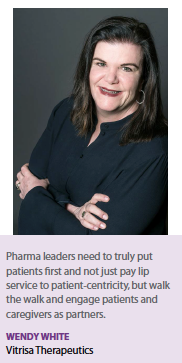 accordingly to continue to drive the culture in a patient-centered direction, especially when it comes to patient voices that, for the most part, go unheard," says Jean-Philippe Milon, Ph.D., CEO of Quantum Genomics.
accordingly to continue to drive the culture in a patient-centered direction, especially when it comes to patient voices that, for the most part, go unheard," says Jean-Philippe Milon, Ph.D., CEO of Quantum Genomics.
Establishing closer relationships and direct communication with all stakeholders — payers, pharmacists, physicians, and patients — is instrumental in ensuring patient adherence to treatment and better outcomes, thus helping realize the commercial potential of a treatment.
“For example, companies have been successful in implementing programs that facilitate greater communication of the patient voice early in drug development through forums, portals, social media monitoring, and patient advocacy groups, so that the outcomes that are most meaningful to the patients are studied," says Susan Najjar, director of marketing and U.S. operations at Sciformix, a Covance company. “This is even more important for rare diseases. A lack of historical data makes it critical to involve the patients in the clinical development process."
The patient voice has become more common in the industry’s protocol design, but it could still use much more input when it comes to creating patient-support services, says Jeff Lee, product lead for patient engagement and eConsent at CRF Bracket. He believes the industry has made tremendous progress in seeking patient input to protocol design, to the point that it is considered standard practice. However, there is still a dearth of patient input into the patient-support features that can be made available for a study. Non-protocol items such as travel, reimbursement, adherence support, and other areas are typically not included in the “patient voice" insights gathered.
“As a result, the industry has a less palpable feel for what patients need to have to execute the best possible study experience," Mr. Lee says. “We have to work harder to focus on the patient-support opportunities as they can often be the most pivotal aspect of the patient being successful in the study."
One reason the industry may not be thinking about the importance of these consumer-type services he says is because, unlike consumer goods products, clinical trials don’t have the same type of consumer pressure that say an Apple product does. However, if the industry thought of patients as consumers, which it should, then it would expect patients to express their buying preferences of the product, in this case, a clinical trial.
To address patient focus in diagnostic testing, Diaceutics implemented a nonprofit organization — the PM Connective — to function as a communications and advocacy platform for all 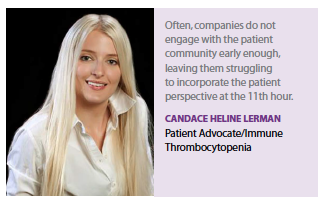 stakeholders in healthcare to embrace the testing needs of patients and to bring formerly disconnected stakeholders together to better work toward facilitating precision medicine.
stakeholders in healthcare to embrace the testing needs of patients and to bring formerly disconnected stakeholders together to better work toward facilitating precision medicine.
According to Diaceutics’ CEO Peter Keeling, the PM Connective is an organization that listens to the needs of patient advocacy organizations, reflects, and brings responsible information back to those organizations so they can adjust and improve the level of education to patients.
“Personalized medicine has the capacity to transform healthcare, but we must always maintain the patient-centric focus because our true success will be measured in health outcomes and the quality of life for patients," he says.
Diaceutics data help determine how effective testing has been for patients as well as how many patients are receiving the tests. This information helps the industry identify gaps that slow the process. “Once a company has the information, it has a choice and the choice can be to do nothing with that information or to change, and in our experience, very, very few companies do nothing," Mr. Keeling says. “My one piece of advice is to measure and identify the way in which patients are being tested, in advance of getting them the treatments, and out of that will flow change."
Just Listen
Patients and caregivers know best what it is like to live with a condition and, their insights can shed light on opportunities to add value and improve the patient experience while simultaneously achieving business objectives, whether determining strategy, creating a campaign, or designing and delivering patient services, says Kristin LaBounty Phillips, managing director, strategy, The Patient Experience Project, an Eversana agency. It is as simple as giving patients, caregivers, advocacy leaders, and healthcare professionals a seat at the table.
“Transforming to a patient-centered model should not require a dramatic change," she says. “Instead, it is a return to simplicity. We simply must listen and then develop patient-support programs that really serve patient needs."
Pharma companies can use digital channels that systemically collect the voice of the patient and share this information with their individual providers for meaningful follow up. Providing real-world feedback on a patient’s experience with a therapy is a great way to keep them connected with their care team between visits. “Brands that include this approach as part of their promotional strategy see measurable new prescription lift and may use the aggregate data to inform their overall messaging," Mr. Sooudi says.
However, experts caution that strapping on a few patient-centered programs does not a shift in company culture make. Creating a patient-focused company culture requires a concerted effort, from the top down, with the company’s vision and mission in mind, and an eye on the end-user. In the past, companies would change internal processes to improve certain business motives, and then wait for the culture to evolve around the improvements. In today’s consumer savvy environment, that method would be ill advised.
Why? Because the industry has changed a great deal. Today’s patients tend to be motivated information seekers and empowered decision-makers with respect to treatment. “Consumers are skeptical of traditional pharma marketing communications, which were designed for the launch and promotion of large blockbuster brands," Ms. Phillips says. “In an age when targeted, orphan, and specialty therapies dominate pipelines and recent FDA approvals, pharma companies need to go beyond traditional DTC advertising. Patients — like all modern consumers — expect companies to deliver value and to foster deep, meaningful relationships. As a result, pharma marketers must evolve their approach by co-creating strategies, programs, and content. Rather than just pushing its own agenda and messages, pharma can engage with healthcare 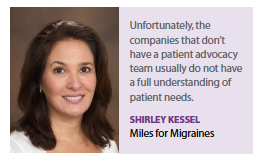 professionals and patients in a meaningful way. Pharma has the potential to be seen as a partner in healthcare delivery, one that cares about adding value for patients as much as it does about shareholder value."
professionals and patients in a meaningful way. Pharma has the potential to be seen as a partner in healthcare delivery, one that cares about adding value for patients as much as it does about shareholder value."
Start-ups, small biotechs, and biopharma companies focusing on rare disease may have an advantage over large pharma companies when it comes to being patient-focused, as the nature of their business relies on the patient voice. It is easier for companies that are just starting out to develop a patient-centered culture from the start. It may be difficult for a large entrenched organization to transform its culture, but there are strategies and best practices that can help.
Since its inception, Paris-based Quantum Genomics has remained steadfastly focused on patient needs. Allowing patients to have a voice and actively listening to any concerns are both vital to the success of a company. “It is crucial to integrate patients into your business model from the very start," Dr. Milon says. “Compiling and considering patient feedback is a great way to ensure a smooth, successful transition to a patient-centered model."
Providing patients with an avenue to voice their needs, priorities, and perspectives is especially crucial in creating a model in which the patient feels like an active partner of the company.
Working with patient advocacy groups and reaching out to key opinion leaders and clinical trial investigators is also an important part of the process when building a patient-centered model.
Engaging patients as active members of the business helps demonstrate a commitment to them and to improving their lives, Dr. Milon says. “Our business strategy includes patients in decision making and development from the beginning so that patients know they can trust us and that their opinions matter," he adds. “In doing so, we incorporate them as key stakeholders and appreciate their guidance as we continue to grow. In fact, one of our strongest drivers is the voice of minority hypertension patient groups whose therapeutic needs are currently severely under-addressed by the healthcare industry."
Jan-Anders Karlsson, Ph.D., CEO Verona Pharma, says advocacy organizations are also an important resource and partner for biopharmaceutical companies, as they help bridge the gap and line of communications between patients, regulators, and industry. “The more recent recognition that patients with common diseases also benefit from a more personalized therapy highlights the role of advocacy groups in partnering with innovator companies to help drive cultural change to address this need," he says. “This is particularly important as companies work to communicate and position the nuances of a treatment with a novel mode of action to ensure the patients’ needs, physicians’ and payers’ views and commercial opportunities are well aligned."
Because Verona Pharma is developing a first-in-class treatment for patients with severe COPD, the company has formed a relationship with the COPD Foundation and by extension COPD patients. “We have had the opportunity to form a strong working relationship with both the foundation and patients, and they have informed our thinking around patients’ symptoms and medical needs in order to more effectively address these in the development of ensifentrine," Dr. Karlsson says. “Furthermore, we invited these constituents to speak about their own experiences in their own voice at our R&D day to highlight the plight of COPD patients, misconceptions about living with the disease, and the urgency for novel treatments, with the shared vision of one day being able to contribute an innovative disease-modifying therapy for COPD patients."
“Patient advocacy groups can often help provide greater insight into the unmet needs of various patient populations and have shaped the drug development process for the identification of additional clinical targets," says Darcy Forman, VP corporate development, Firma Clinical 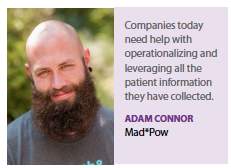 Research. “There are multiple examples of therapeutic agents that are used for the treatment of disease symptoms instead of the disease itself, all the result of pharma companies respecting patients’ multi-faceted needs. The use of wearables, ePRO, and remote clinical study visits have also made the way into pharma companies, but the greatest impact of these innovations is yet to be realized and continues to be an area of untapped potential."
Research. “There are multiple examples of therapeutic agents that are used for the treatment of disease symptoms instead of the disease itself, all the result of pharma companies respecting patients’ multi-faceted needs. The use of wearables, ePRO, and remote clinical study visits have also made the way into pharma companies, but the greatest impact of these innovations is yet to be realized and continues to be an area of untapped potential."
Making the Transition
Genuine patient-centricity comes from a complete understanding of the patient’s experience of his or her condition. It begins with knowing what the individual patient values and needs and what is most likely to result in a positive healthcare outcome in that context. This understanding is a powerful tool when it comes to decision making at every stage of a pharma company’s efforts, from drug discovery to winning regulatory approval to postmarket disease management.
Transitioning to a value-based business model with the patient at the center will become unavoidable if pharma wants to meet the needs of all its stakeholders, including payers, physicians, and of course, patients.
Patient-centricity is not just for marketing strategies; it will become the foundation of the entire corporate culture. Firma, a boutique CRO, believes that taking a patient-centric approach and making participating in a clinical trial easier and more valuable for the patients, while at the same time increasing the quality of the data collected and decreasing the timelines, benfits both patients and pharma. This requires building patient-centric approaches directly into the clinical study design.
“Patients are the core of the trial and should be at the center of the researchers thinking and priorities," Ms. Forman, says. “This means, for example, not expecting the patient to commute to the site for every visit. Instead, it means valuing the patients’ time and effort by ensuring rapid data analysis, high-quality regulatory submissions and bringing effective treatments to the market faster."
Ms. Forman says the industry, especially large pharma and biotech companies, are investing in patient engagement liaison roles to help steer this transition.
“The individuals in these roles are dedicated to patient advocacy and implementing patient-centric approaches into their organization’s portfolio execution," she says. “There is extreme value in these positions as it showcases the acknowledgement of the industry that patients are not commodities. But there is need to accelerate the adoption of patient centric approaches beyond patient advocacy."
Wendy White, chief patient officer, Vitrisa Therapeutics, agrees that these new roles and the emergence of more senior titles with the role of advocacy attached are showing up in pharma rosters.
“The new roles and positions indicate the recognition of the importance of engaging patients as partners at every stage of therapy design and development on the business of developing effective therapies," Ms. White says.
Tim Armand, cofounder and president of Health Union, says he has witnessed a big surge in pharma discussions about incorporating the patient voice. “There is a lot of discussion about patient-centricity along every step in the journey, from R&D to commercialization," he says. “However, it seems that there isn’t a whole lot of action to accompany the talk."
Mr. Armand attributes the difficulty of bringing the patient voice and experience into the conversation to pharma’s hesitation to allocate the resources. “Patient-centricity requires a thorough, uninhibited understanding of the realities of the journey and all of the factors that affect decisions," he says. “Doing so requires significant time, resources and absolute dedication to the purpose, which can be hard to come by in this industry."
At Health Union, the company serves the needs of people living with chronic health conditions, including patients and caregivers. Patients have been, and will continue to be, the key drivers of each condition-specific community’s content, design, and function. Pharma should be tapping into this business strategy to reach and engage patients in the most relevant and efficient ways available to them. A pharma company’s assets are now more than just its treatments, and a deep understanding of patients needs to be aligned to business strategy, he adds.
“The deep understanding of our communities is directly aligned to our business strategy and gives our partners opportunities to reach and engage patients in the most relevant and efficient ways available," Mr. Armand says.
Not only is it imperative that pharma includes the view of the patient in everything it does, it also needs to shorten the distance between the people making the decisions and the patients themselves, says Mr. Connor of Mad*Pow. This practice is increasingly being adopted in the technology industry, where it is trying to create a work environment where people can make decisions without running everything up the corporate ladder first. The movement strives to create more autonomous teams that can decide what they want to do for whatever product they work on.
“This whole movement is about decreasing the distance between the decision makers and the people gathering the information, and is something we try to incorporate at when we work with pharma organizations as well," Mr. Connor says.
Patients to Pharma: Do More
In her role as executive director of Miles for Migraine, Shirley Kessel has worked with industry on patient-centric efforts, and in her case, the experience was good. However, there needs to be many more such opportunities for many more patients to make a difference. Supporting patients needs to go beyond medication and include support or opportunity for patients to connect with one another. Companies need to form stronger bonds with advocacy groups and encourage the involvement of HCPs and their patients.
“Companies need to embrace the concept that advocacy is a vital part of the treatment plan and invite HCPs and their patients to live participatory events such as a Miles for Migraine walk/run or education day," Ms. Kessel says.
It is also imperitive for pharma companies to have a dedicated advocacy team that is solely responsible to collaborate with nonprofit patient organizations. “Companies that don’t have advocacy teams usually don’t have a full understanding of patient needs," she says.
She has worked with Amgen’s dedicated advocacy department, one of Miles for Migraine’s highest-level sponsors. Ms. Kessel says Amgen is one the most patient-centric companies the 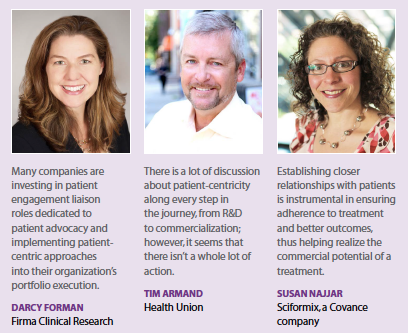 organization works with. “Because Amgen has listened to our needs and has said yes to almost every idea we have put before it, Miles for Migraine has been able to reach and support significantly more patients and has made great leaps in the number of events we hold," she says. “Amgen’s teams understand that advocacy needs to be part of a treatment plan and that it’s only in the setting of a live patient forum that migraine will be understood by the public as a disabling disease."
organization works with. “Because Amgen has listened to our needs and has said yes to almost every idea we have put before it, Miles for Migraine has been able to reach and support significantly more patients and has made great leaps in the number of events we hold," she says. “Amgen’s teams understand that advocacy needs to be part of a treatment plan and that it’s only in the setting of a live patient forum that migraine will be understood by the public as a disabling disease."
Another company Miles for Migraines has teamed up with invited patient advocates and HCPs to a meeting-of-the-minds event.
“It was refreshing and very validating for all of the patient advocates to see that a company recognized our opinions and that they are just as valuable as the HCPs," Ms. Kessel says. “But we need to see more of this for the industry to truly become patient-centric."
Ms. Kessel recently gave a presentation to a sales team at a small pharma company about why advocacy is necessary for a cure. If all companies would teach their employees about the day-to-day life of a patient, this would inspire dialogue that could become part of their sales presentations to HCPs. “Sharing my years of experience in this space with this team was a sign that the industry is moving toward greater patient involvement, but there is clearly more work to be done," she says. “For example, a headache doctor friend shared with me a conversation he had with a non-headache specialist who said, ‘I’m glad you’re taking care of these patients because I would never want to. They are impossible to treat.’ My friend explained to him why this was a stigmatizing comment."
Lawyer, patient advocate, and rare disease patient Candace Lerman has worked with numerous pharma-centric departments, lending her voice as both a patient and attorney for various projects. Her experience has been mutually beneficial, as she can present advice and insight from two very important — but often vastly different — angles. “It is my hope that as the industry continues to evolve and improve, we can build more bridges between the patient voice and how the law regulates various aspects of the industry," Ms. Lerman says.
She suggests that pharmaceutical companies identify key patient advocates in a disease space and work closely with them. Funding education initiatives and building partnerships with disease groups can make a huge difference in designing effective programs and launching new products. Often, companies do not engage with the patient community early enough, leaving them struggling to incorporate the patient perspective at the 11th hour.
As a caregiver and a chief patient officer, Ms. White also has suggestions for how pharma can do more toward patient-centricity, such as sharing failed trial results so that the next company can move faster, or collaborating on public patient registries that are owned and controlled by patients and engage patients and caregivers as partners in the process, starting with helping to inform clinical trial design through identifying barriers to adherence and even informing lifecycle management. “The bottom line is that pharma leaders need to truly put patients first," Ms. White says. “This means more than paying lip service to patient-centricity and walking the walk and engaging patients and caregivers as partners. Good relationships require good communication: being authentic, transparent, following through, listening, knowing which battles to fight, stepping up and being kind."(PV)
~~~~~~~~~~~~~~~~~~~~~~~~~
Patient Focus Leads to Profitability
A recent Aurora Project study reveals that there is profitability in companies having a patient focus. The Aurora Project’s 2016 global benchmark survey comprised 2,346 pharma respondents from 84 countries. One of the key insights was that 86% of participants ranked the importance of delivering on patient-focused missions as greater than eight out of 10, but only 21% ranked their confidence in their own company delivering on these missions.
A large majority of the respondents — 93% — believe the integration of a patient-focused strategy has improved overall business outcomes by:
58% increasing employee engagement
58% HCP trust
56% patient trust
56% stakeholder engagement
40% revenue
Respondents were also positive for payers and government trusts (37%) as well as employee attraction/retention (36%).
The Aurora Project was spearheaded from an initial survey conducted in 2016, when the results of that survey warranted creating a volunteer group to continue the conversation around patient centricity. Paul Simms, chairman of eyeforpharma, and Jill Donahue and John Elliot, both of EngageRx, are co-founders.
~~~~~~~~~~~~~~~~~~~~~~~~~
TGaS Advisors Patient-Centricity Study
 “A key improvement that we have seen in the industry is centralizing resources — both headcount and budget — outside of the brand team. This allows companies to focus on key initiatives, such as patient health literacy, patient co-creation activities, and even call center dialogue that can help break down the barriers of a complex conversation into a human dialogue," says Sue Lipinski, executive director, omnichannel marketing, TGaS Advisors.
“A key improvement that we have seen in the industry is centralizing resources — both headcount and budget — outside of the brand team. This allows companies to focus on key initiatives, such as patient health literacy, patient co-creation activities, and even call center dialogue that can help break down the barriers of a complex conversation into a human dialogue," says Sue Lipinski, executive director, omnichannel marketing, TGaS Advisors.
A January 2019 TGaS Advisors study polled pharmaceutical marketers about their top priorities heading into the year; improving customer-centricity came in as No. 1. Although customer-centricity is a broad term, improving patient-centricity has taken on a more tangible function in some leading organizations. Those organizations consist of either a centralized function, with a headcount average of 5.2, or in some cases a decentralized model responsible for pulling through their patient centricity vision. Of those surveyed, 83% of centralized groups’ responsibilities span clinical and in-market patient experience activities, specifically:
Health literacy initiatives
Medical information contact center
Patient-support programs
However, some patient experience groups weigh their efforts on either clinical-trial related capabilities or adherence-related efforts, driven by overarching business initiatives.


















